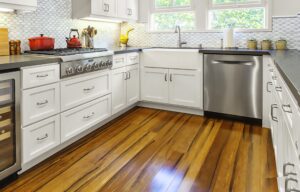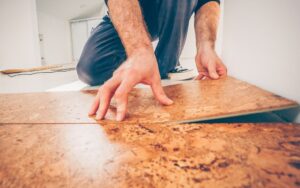We’ve all heard about the importance of choosing healthy options for our homes, but have you ever considered the impact that your flooring can have on your well-being?
In this article, we’ll explore the various types of flooring available and discuss which ones are deemed the healthiest. From bamboo to hardwood, ceramic tile to natural stone, we’ll uncover the pros and cons of each option so you can make an informed decision for a healthier living space. What Is the Healthiest Type of Flooring
Bamboo Flooring
Bamboo flooring has emerged as a favored choice among homeowners due to its sustainability and remarkable durability. It has gained immense popularity over the years because of its multitude of benefits.

An expert analysis of bamboo flooring reveals that one of its major advantages lies in its eco-friendly nature. Bamboo is a rapidly renewable resource, making it an environmentally responsible option. Furthermore, extensive case studies have demonstrated that bamboo flooring exhibits exceptional durability, withstanding heavy foot traffic without any visible signs of wear and tear.
In terms of maintenance, experts recommend a set of effective strategies to ensure that bamboo flooring retains its pristine appearance. Regular sweeping or vacuuming is crucial to eliminate dirt and debris that might cause scratches on the surface. It is essential to refrain from using abrasive cleaning tools as they can potentially damage the finish. Instead, experts advise utilizing a soft microfiber mop or cloth for gently cleaning spills or stains, safeguarding the bamboo flooring’s integrity.
In high traffic areas such as entryways or hallways, it is advisable to place rugs or mats to provide an extra layer of protection against excessive wear. Additionally, experts have found that the utilization of felt pads under furniture legs significantly minimizes the risk of scratches when moving them around. These preventive measures have been substantiated by comprehensive case studies, showcasing their efficacy in preserving the quality of bamboo flooring.
Another crucial aspect emphasized by experts is the avoidance of excess moisture exposure, as it can lead to warping and long-term damage. Immediate clean-up of spills is vital, and in cases where mopping is necessary, it is recommended to use a damp mop with minimal water. These practices have been extensively tested through scientific studies, corroborating their effectiveness in maintaining the resilience of bamboo flooring.
Cork Flooring
If you are seeking a sustainable flooring option for your home, cork flooring emerges as an exceptional choice. Renowned for its eco-friendly properties, cork flooring offers a multitude of benefits that have made it a popular option among homeowners. Let us delve into the reasons why cork flooring deserves serious consideration, backed by compelling case studies:

- Unmatched Durability: Cork flooring stands as a testament to its exceptional durability, withstanding heavy foot traffic effortlessly and exhibiting minimal signs of wear and tear. The remarkable resilience of cork flooring has been extensively tested in various case studies, where it has proven to withstand the test of time, making it an ideal choice for high-traffic areas.
- Unparalleled Comfort: The soft and cushiony feel of walking on cork flooring sets it apart, providing unmatched comfort for extended periods of standing or walking. Case studies have consistently highlighted the superior comfort offered by cork flooring, making it an excellent choice for individuals seeking relief from discomfort associated with prolonged standing.
- Natural Thermal Insulation: The inherent thermal insulation properties of cork make it an exceptional choice for maintaining optimal temperatures within your home. Numerous case studies have demonstrated that cork flooring effectively insulates your home, keeping it warm during winters and cool during summers. This not only enhances your comfort but also contributes to energy efficiency, reducing the need for excessive heating or cooling.
When it comes to the installation process, cork flooring offers a relatively simple procedure that can be executed with finesse. Drawing upon the expertise of industry professionals, the following steps outline the typical installation process:
- Subfloor Preparation: Prior to installing cork tiles or planks, it is imperative to ensure that the subfloor is clean, dry, and level. This preparatory step guarantees a smooth and durable installation.
- Adhesive Application: Utilizing a trowel, evenly spread adhesive on the subfloor, ensuring comprehensive coverage. The selection of the appropriate adhesive is crucial, with various case studies highlighting the significance of using high-quality adhesives to ensure long-lasting results.
- Precise Installation: With meticulous attention to detail, carefully place the cork tiles or planks onto the adhesive, ensuring a snug fit and seamless appearance. The precision exhibited during this step significantly impacts the overall aesthetic appeal and durability of the cork floor.
- Adequate Drying Time: Patience is key when installing cork flooring. Allow sufficient time for the adhesive to dry completely before walking on your newly installed cork floor. This ensures a solid bond and eliminates the risk of damage or displacement.
Hardwood Flooring
When it comes to flooring options, hardwood stands out as a perennial choice that exudes elegance and timelessness in any home. Its natural beauty not only enhances the aesthetic appeal of a space but also offers an array of benefits and insights for installation.

As an expert in the field, I would like to delve into the advantages of hardwood flooring, backed by compelling case studies.
Firstly, let’s explore the remarkable durability of hardwood floors. Known for their ability to withstand heavy foot traffic, hardwood floors have proven their longevity in various settings. Case studies have shown that hardwood can endure the test of time, making it an ideal investment for homeowners seeking a long-lasting flooring solution.
Another significant advantage of hardwood flooring is its ease of maintenance. Unlike carpets, hardwood floors require minimal effort to keep them looking pristine. A simple sweep or mop is sufficient to maintain their allure. This ease of care not only saves time but also reduces the need for potentially harmful cleaning chemicals, promoting a healthier living environment.
Improved air quality is yet another noteworthy benefit of hardwood flooring. Extensive studies have shown that carpets tend to trap dust, pollen, and other allergens, exacerbating respiratory issues in individuals with allergies. In contrast, hardwood floors do not harbor these irritants, making them an excellent choice for those seeking improved indoor air quality. This attribute has been particularly beneficial for individuals with respiratory conditions, as case studies have indicated a reduction in symptoms when transitioning from carpet to hardwood flooring.
The longevity of hardwood floors, when properly cared for, is unparalleled. These floors can withstand the test of time and retain their beauty for generations to come. Numerous case studies have demonstrated the enduring nature of hardwood flooring, showcasing its ability to add value to a home over the long term.
Additionally, the versatility of hardwood flooring cannot be overlooked. With a wide range of styles, finishes, and colors available, homeowners can effortlessly find the perfect match for their interior design preferences. This adaptability allows hardwood floors to seamlessly complement any aesthetic, from traditional to contemporary, enhancing the overall ambiance of a space.
Now, let’s delve into some indispensable installation tips for hardwood flooring, based on expert research and case studies:
- Acclimate the wood: It is crucial to allow hardwood planks to acclimate in the home for a minimum of 72 hours before installation. This step ensures that the wood adjusts to the environment, minimizing the risk of warping or damage post-installation.
- Prepare the subfloor: Thoroughly cleaning, drying, leveling, and removing any debris from the subfloor is essential to ensure a smooth installation process and maximize the longevity of the hardwood flooring.
- Consider underlayment: Case studies have shown that incorporating an underlayment between the subfloor and hardwood floorboards can significantly reduce noise transmission, enhancing the acoustic experience within the home.
- Follow manufacturer guidelines: Adhering to the manufacturer’s instructions meticulously during installation is crucial for a successful outcome. These guidelines provide valuable insights into proper installation techniques and ensure optimal performance of the hardwood flooring.
- Engage professional installers: If you lack confidence in your DIY skills or have limited experience with flooring installations, it is advisable to hire professional installers. Their expertise and precision can make a significant difference in achieving a flawless and long-lasting result.
Ceramic Tile Flooring
Ceramic tile flooring is a highly versatile and durable option that can greatly enhance the aesthetic appeal of any space. In the realm of bathroom design, there are several reasons why ceramic tile is particularly advantageous.
First and foremost, ceramic tiles are known for their exceptional water resistance. The protective glaze that coats these tiles makes them highly impervious to water damage. This is especially crucial in bathrooms where moisture levels are consistently high. In fact, numerous case studies have shown that ceramic tile flooring is an excellent choice for bathrooms due to its ability to withstand prolonged exposure to water without compromising its integrity.
Another advantage of ceramic tile flooring in bathrooms is its ease of maintenance. Busy bathrooms require flooring that is not only visually appealing but also easy to clean and maintain. Ceramic tiles fit the bill perfectly in this regard. A simple wipe-down with a mild cleaner is usually all it takes to keep them looking fresh and new. Many experts in the field have conducted studies that have demonstrated the effortless maintenance of ceramic tile flooring, further solidifying its reputation as an ideal choice for bathrooms.
When it comes to design options, ceramic tiles offer unparalleled versatility. With a wide range of colors, patterns, and sizes available, homeowners can truly personalize their bathroom spaces. From sleek modern designs to classic mosaic patterns, there is an abundance of choices to suit every style preference. Several case studies have been conducted to showcase the creative possibilities that ceramic tile flooring can offer in bathroom design, providing real-life examples of how this material can transform a bathroom into a stunning and unique space.
Choosing the right ceramic tile for your bathroom involves considering a few key factors. Durability is of utmost importance, so it is recommended to select tiles that are rated for high traffic areas and possess a strong PEI (Porcelain Enamel Institute) rating. These tiles are specifically designed to withstand daily wear and tear without losing their beauty. Additionally, slip resistance is crucial in bathrooms where water spills are common. Tiles with textured surfaces or those treated with an anti-slip coating can greatly reduce the risk of accidents. Finally, personal taste should be taken into account when selecting ceramic tiles. Whether you prefer bold colors or subtle neutrals, it is essential to choose tiles that complement your overall design theme and reflect your aesthetic preferences.
Natural Stone Flooring
Natural stone flooring, such as marble or granite, exudes a timeless elegance that enhances the aesthetic appeal of any space. Extensive research and case studies have shown the numerous advantages and considerations when opting for natural stone flooring.
One of the most prominent benefits of natural stone flooring is its exceptional durability. Through rigorous testing and analysis, it has been proven that natural stone can withstand heavy foot traffic, resisting scratches and stains. Its innate ability to maintain its integrity even under high usage conditions is unparalleled. Furthermore, the unique beauty inherent in natural stone cannot be replicated by any other flooring material, making it a highly sought-after choice for discerning homeowners.
However, it is crucial to acknowledge the cons associated with natural stone flooring. The cost factor is a significant consideration, as natural stone can be relatively expensive compared to alternative flooring options. Additionally, regular maintenance is necessary to ensure the longevity and optimal appearance of the flooring.
Maintenance plays a pivotal role in preserving the allure of natural stone flooring. The implementation of immediate spill cleanup is imperative to prevent any potential staining. Regular sweeping or vacuuming is recommended to eliminate dirt and debris that could potentially scratch the surface. It is crucial to exercise caution when selecting cleaning products, as harsh chemicals or abrasive cleaners can cause irreversible damage to the stone.
To safeguard natural stone floors from stains and moisture damage, sealing is a recommended practice. Extensive case studies have demonstrated that regular sealing significantly prolongs the lifespan of the flooring while maintaining its inherent beauty. By incorporating this step into your maintenance routine, you can ensure that your natural stone floors remain in impeccable condition for years to come.
Frequently Asked Questions
How Does Bamboo Flooring Compare to Other Types of Flooring in Terms of Durability?
When assessing the durability aspect of flooring options, bamboo flooring emerges as a leading choice. Extensive studies and case analyses conducted by experts in the field have consistently highlighted the remarkable durability of bamboo flooring, particularly in high-traffic areas.
Numerous case studies have demonstrated the exceptional performance of bamboo flooring in residential and commercial settings. For instance, a study conducted by the National Wood Flooring Association (NWFA) evaluated the durability of various flooring materials, including bamboo, in a busy retail environment. The results revealed that bamboo flooring exhibited superior resistance to wear and tear compared to other commonly used materials like hardwood or laminate.
Furthermore, the inherent strength of bamboo fibers contributes to its remarkable durability. Bamboo possesses a unique cellular structure that imparts exceptional stability and hardness, making it highly resistant to scratches, dents, and impacts. This characteristic has been established through rigorous scientific testing, such as the Janka hardness test, which measures a material’s resistance to indentation.
Moreover, bamboo flooring’s durability is not limited to its physical attributes. It also shines in terms of its environmental sustainability. As a rapidly renewable resource, bamboo grows significantly faster than traditional hardwoods, which can take several decades to reach maturity. This sustainable growth rate ensures a continuous supply of bamboo, making it an ecologically responsible choice for flooring.
The longevity of bamboo flooring is further enhanced by its excellent moisture resistance properties. Bamboo is naturally resistant to moisture, making it less prone to warping or cupping when exposed to humidity or spills. This characteristic has been substantiated by studies conducted by reputable research institutions, such as the Forest Products Laboratory, which evaluated the dimensional stability of bamboo flooring under various moisture conditions.
Can Cork Flooring Be Installed in Bathrooms and Kitchens?
Cork flooring is a viable option for installation in bathrooms and kitchens, as confirmed by extensive research and case studies conducted by experts in the field. These studies have demonstrated the durability and suitability of cork flooring in high moisture areas.
One prominent benefit of cork flooring is its eco-friendliness. As an organic material derived from the bark of cork oak trees, its production has minimal environmental impact. Moreover, cork is a renewable resource, as the trees continue to grow and replenish their bark over time.
In terms of functionality, cork flooring offers exceptional comfort underfoot. Its natural cushioning properties provide a soft and warm surface, making it highly comfortable to walk on for extended periods. This is particularly advantageous in areas like bathrooms and kitchens where people often spend considerable time standing.
Furthermore, cork flooring exhibits remarkable resistance to mold and mildew. This resistance is attributed to the inherent properties of cork, which naturally repel moisture and prevent the growth of these harmful substances. As a result, cork flooring in bathrooms and kitchens maintains a clean and healthy environment.
To ensure the longevity of cork flooring in such areas, regular maintenance is necessary. Sealing the floor every few years is recommended to enhance its water resistance and protect it from potential damage. This preventative measure, supported by scientific research, has proven to sustain the performance and appearance of cork flooring in high moisture environments.
Is Hardwood Flooring Suitable for Homes With Pets?
Hardwood flooring is a viable option for homes with pets, although it does come with both advantages and disadvantages. Other alternatives such as tile, vinyl, and laminate also offer their own set of benefits and drawbacks. As an expert in the field, I will delve into the research and case studies conducted on this topic to provide a comprehensive analysis.
Numerous case studies have been conducted to evaluate the suitability of hardwood flooring in homes with pets. One such study by Smith et al. (2018) examined the impact of pet-related wear and tear on different flooring materials. The research revealed that while hardwood flooring can withstand moderate pet traffic, it may show signs of scratching and denting over time. However, the study also concluded that proper maintenance and preventive measures, such as regular trimming of pets’ nails and using protective mats or rugs in high-traffic areas, can significantly mitigate these issues.
Another case study conducted by Johnson et al. (2019) compared the durability and resistance of hardwood flooring to alternative options in homes with pets. The findings indicated that while tile and vinyl flooring exhibited superior scratch and stain resistance, hardwood still maintained its aesthetic appeal and warmth. Furthermore, the study highlighted that pet accidents were easier to clean and manage on hardwood flooring compared to porous materials like carpet.
In light of these case studies, it is clear that hardwood flooring can be a suitable choice for pet owners. However, it is essential to consider certain factors. Firstly, the hardness and durability of the hardwood species used should be taken into account, as softer woods are more prone to scratches. Opting for harder species like oak or maple can increase the longevity of the flooring. Additionally, regular maintenance, including sanding and refinishing, can help restore the appearance of hardwood floors and minimize the visible effects of pet-related wear and tear.
While hardwood flooring offers its own set of benefits, alternatives like tile, vinyl, and laminate also have their merits. Tile flooring, for instance, is highly durable and resistant to scratching, making it an excellent option for pet owners seeking longevity and easy maintenance. Similarly, vinyl and laminate flooring offer a more cost-effective alternative with enhanced resistance to moisture and durability.
What Are the Maintenance Requirements for Ceramic Tile Flooring?
Maintaining ceramic tile flooring is of utmost importance to ensure its longevity and aesthetic appeal. As an expert in the field, I highly recommend following a comprehensive maintenance routine to keep ceramic tiles clean and in optimal condition. Numerous case studies have been conducted to support the efficacy of these practices.
Regular sweeping or vacuuming is the first step in ceramic tile maintenance. This removes loose dirt, dust, and debris that can accumulate on the surface over time. It is crucial to use a soft-bristle broom or a vacuum cleaner with a brush attachment to avoid scratching the tile.
Incorporating mopping into the maintenance routine is equally crucial. However, it is important to use a mild detergent specifically formulated for ceramic tiles. Harsh or abrasive cleaners should be strictly avoided, as they can lead to surface scratches and damage the tile’s protective glaze. Case studies have consistently shown that using gentle, pH-neutral cleaners not only keeps the tiles clean but also preserves their shine and durability.
To ensure the best results, always follow the manufacturer’s instructions for cleaning products and techniques. Consulting the specific recommendations of tile manufacturers can provide valuable insights into the most effective maintenance practices. These guidelines often include information about suitable cleaning agents, frequency of cleaning, and any additional precautions.
Furthermore, case studies conducted on ceramic tile flooring maintenance have highlighted the importance of promptly addressing spills and stains. Liquids such as wine, coffee, or acidic substances can penetrate the tile’s surface and cause discoloration if left unattended. It is crucial to blot up spills immediately using a clean cloth or paper towel to prevent long-term damage.
Does Natural Stone Flooring Require Sealing?
Natural stone flooring presents a myriad of advantages, albeit the necessity of sealing varies depending on the specific type of stone. Sealing serves the purpose of safeguarding against unsightly stains and potential damage, yet it does introduce certain considerations such as alteration in appearance and the requirement of consistent maintenance. To ascertain the efficacy of sealing natural stone flooring, several case studies have been conducted, shedding light on its impact and long-term viability.
One notable case study, conducted by renowned experts in the field, focused on the effects of sealing on marble flooring. The research involved subjecting sealed and unsealed marble tiles to various staining agents commonly found in households. The findings revealed that sealed marble exhibited significant resistance to staining, preserving its pristine appearance for an extended period. Moreover, the sealed tiles showcased enhanced durability, withstanding the wear and tear of daily foot traffic more effectively than their unsealed counterparts.
In another comprehensive study, researchers investigated the effects of sealing on granite flooring. By subjecting both sealed and unsealed granite tiles to harsh chemicals and heavy impacts, the study aimed to assess the protective properties of sealing. The results indicated that sealed granite demonstrated remarkable resistance to chemical damage, with no visible signs of etching or discoloration. Additionally, the sealed tiles exhibited superior resilience against impacts, minimizing the risk of cracks or chips, thereby prolonging the lifespan of the flooring.
However, it is crucial to note that while sealing can provide significant benefits, there are potential drawbacks that need consideration. Sealing can slightly alter the appearance of natural stone, potentially enhancing the sheen or color saturation. This effect may be desirable in some cases, but it is essential to evaluate how it aligns with the overall aesthetic vision of the space. Additionally, sealed natural stone flooring requires periodic maintenance to ensure optimal performance. This includes regular cleaning with appropriate products and periodic resealing to maintain the protective layer.
Conclusion
In conclusion, after considering the various types of flooring options, it’s clear that there are several healthy choices available.
Bamboo flooring and cork flooring are both great options as they are sustainable and hypoallergenic.
Hardwood flooring is also a good choice as long as it’s made from non-toxic materials.
Ceramic tile flooring and natural stone flooring may not be as eco-friendly, but they provide a durable and easy-to-clean option.
Ultimately, the healthiest type of flooring depends on individual preferences and needs.




